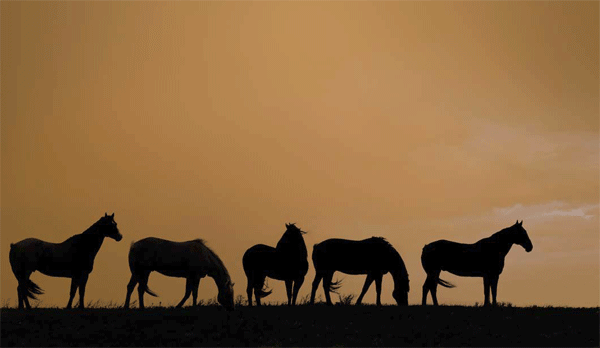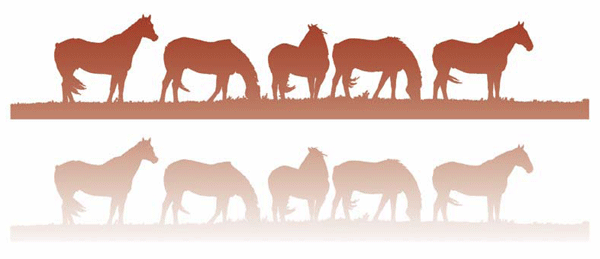U.S. horse slaughter exports to Mexico increase 312%
Since all three U.S. horse slaughter operations were ordered closed last year, the number of horses exported to Mexico for slaughter has exploded. As of Dec. 20, 2007, 44,475 horses had been shipped to Mexico for processing for human consumption compared with 10,783 shipped at the same time in 2006—a 312 percent increase.

Especially troubling is the treatment of the horses once they cross the border into Mexico. In October, the Humane Society of the United States released a video showing the brutal stabbing death of a fully conscious horse at a Mexican slaughter facility. "It is time for this carnage to end," said Nancy Perry, HSUS vice president of government affairs, who called on Congress to close the border to horse slaughter exports.
In addition, American horse exports to Mexico for purposes other than slaughter, such as for breeding or recreation, have nearly doubled in the same period. This increase is raising concerns that many of these horses are actually being sent to slaughter but shipped under false pretenses to circumvent U.S. transport regulations governing the animals' welfare.
Despite the shuttering of the three U.S. horse slaughter plants, exporting horses for processing remains legal. Horse enthusiasts, however, have for years been pushing for a federal ban on what they say is an inhumane and un-American practice. The American Horse Slaughter Prevention Act, currently pending in Congress, would prevent any horse slaughter facility from operating in the United States as well as prohibit the shipment of horses to other countries for processing.
The AVMA and other AHSPA opponents contend that the assault of the anti-horse-slaughter coalition, led by HSUS, on the federally regulated horse slaughter industry has, in fact, led to the current welfare crisis. Unwanted horses fared much better when they were transported under government supervision to U.S. regulated facilities and humanely euthanized, they say. (Cavel International Inc., the foreign-owned operator of the Illinois slaughter plant, is appealing the state ban to the U.S. Supreme Court.)
"The reality is, proponents of this legislation have done nothing to address the real issue here, and, in fact, by seeking to ban horse slaughter, they have made things significantly worse," said Dr. Mark Lutschaunig, director of the AVMA Governmental Relations Division. Opponents of the federal ban say its supporters should instead focus their energies on addressing what to do with the some 100,000 horses relinquished by their owners each year to slaughter.

The end for horses sent to one of the U.S. slaughter plants was anything but humane, according to the HSUS. The regulations meant to protect them were inadequate as the horses suffered from a lack of food and water on crowded trailers, and the euthanasia was often mishandled, the organization claims. Rather than being slaughtered, HSUS says, unwanted horses can be placed with a rescue or retirement facility or, when no other options are available, humanely euthanized.
While there is little about horse slaughter on which the AVMA and HSUS agree, they're of the same mind when it comes to the serious welfare problem posed by the skyrocketing American horse slaughter exports to Mexico.
Given the high volume of American horses slaughtered annually when the U.S. processors were open, a spike in U.S. equine exports to Mexico was expected once they closed. According to the Department of Agriculture, a total of 138,206 American horses were processed in 2006. Of those, 102,260 were sent to U.S. facilities, 24,866 to Canadian facilities, and 11,080 to Mexican facilities.
But a fourfold increase in U.S. equine exports to Mexico, fueled by a growing surplus of unwanted horses at home and a high demand for horse meat abroad, still came as a surprise to some. "These are just remarkable numbers and not something I think any of us would have anticipated, even with the closing of the plants," said Dr. Timothy Cordes, senior staff veterinarian for equine programs with the USDA Animal and Plant Health Inspection Service.
The USDA estimates that 35,000 horses were sent to Canada for slaughter in 2007—about a 41 percent increase from the year before. Horse slaughter opponents are trying to shut down the industry there with a Canadian version of the American Horse Slaughter Prevention Act.
The Mexican horse slaughter industry is more worrisome than its Canadian counterpart, especially since more is known about the Canadian industry, which adheres to transport and euthanasia regulations similar to those in the United States. "One of the most daunting things about all of this is, once a horse crosses the border, it is no longer a U.S. horse. It becomes a Mexican horse. It loses its identity, it loses its citizenship, it loses its ownership," Dr. Cordes said.
When contacted by JAVMA News for information about their country's horse slaughter policies, Mexican officials referred to regulations stating the animals must be humanely euthanized in sanitary conditions.
Trying to get an idea of how the Mexican horse slaughter industry operates, a delegation from the American Association Equine Practitioners arranged a tour of several Mexican slaughter facilities in November 2007. But, according to Dr. Tom Lenz, chair of AAEP welfare committee, Mexican plant owners canceled the trip after recent negative media stories. The visit is being rescheduled and will most likely happen in early 2008. "The big question that's not been answered yet is how those (American) horses are handled in Mexican processing plants and euthanized," Dr. Lenz said.
Late last year, Dr. Lenz and other AAEP officials met with Mexican equine veterinarians to discuss the plants. Although he isn't positive, Dr. Lenz believes most American horses are going to facilities owned by European companies where horses are euthanized either by a captive bolt or gunshot, the same as in the United States and as required by Mexican law. Exact numbers aren't known but there may be as many as four such operations in Mexico, he said.
They might also be going to facilities that are in the process of becoming certified to export horse meat to Europe. "We're not 100 percent sure which type of plant American horses are going to, but it's one or the other," he said.
There are two other types of slaughter facilities in Mexico: municipal plants that process horses for local consumption and so-called clandestine facilities. "They're not regulated plants," Dr. Lenz said. "They're local butcher shops ... and that's where the greatest concern about how the horses are being handled and euthanized is." He believes it's this sort of operation featured in the HSUS video.
 Another question is, if the slaughter ban were enacted, what would happen to all those horses whose owners no longer want them or can afford to keep them? Ban supporters say the nation's equine rescue and retirement facilities can absorb many of them. The HSUS points to groups such as the New York Racing Association that are raising money and working toward solutions for unwanted horses. Additionally, owners can opt for humane euthanasia by a veterinarian.
Another question is, if the slaughter ban were enacted, what would happen to all those horses whose owners no longer want them or can afford to keep them? Ban supporters say the nation's equine rescue and retirement facilities can absorb many of them. The HSUS points to groups such as the New York Racing Association that are raising money and working toward solutions for unwanted horses. Additionally, owners can opt for humane euthanasia by a veterinarian.
Ban opponents respond that this isn't realistic. Without the humane slaughter alternative, countless horses would be neglected or abandoned because there won't be enough homes for them. The AAEP estimates an additional 2,700 rescue facilities would be needed in the first year of the ban to care for the thousands of surplus horses. The costs of euthanasia and environmentally safe carcass disposal can run as much as $400 and may be more than some owners are willing to pay. Making matters worse is a hay shortage, brought on by droughts, which is making it more expensive to feed horses.
Then there's the strength of the international horse meat market, partly a result of outbreaks of bovine spongiform encephalopathy in European cattle. The price of horse flesh in Belgium is at an all-time high, according to Dr. Cordes. Considering the demand for horse meat and a surplus of unwanted horses in America, even under a federal transport prohibition preventing horses from crossing into Canada and Mexico for slaughter would be a challenge.
"It's really a matter of supply and demand. These horses are going to go across the border, one way or another," Dr. Cordes said, adding that the $5 million allocated in the horse slaughter prevention legislation for enforcement purposes isn't adequate to secure the borders. "It doesn't even come close," he said.